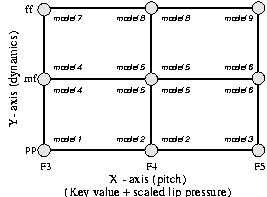
Figure 3: Expressive Timbral Subspace
The additive synthesis engine used for this project was implemented on
a system consisting of an SGI workstation running IRCAM's FTS
software. For the purpose of interpolation we constructed a 2
dimensional expressive timbral subspace covering a 2 octave clarinet
range with three different dynamic levels. (See Figure 3).

Although this approach seems very similar to the one taken in sample synthesizers - with the advantage of having a control (by interpolation) over the sustained portion of the sound - there is an important conceptual point to our approach which should be noted. By considering the additive method, we consider interpolation not between actual sounds but between models, and thus the issue of modeling is central to this work.
A simple noise source is also modeled in order to provide an approximation to the actual clarinet sound, since the models used for interpolation are issued from additive synthesis and therefore do not contain the noise components of the original sound. Within all mapping examples the noise level is controlled by a ratio of breath pressure to embouchure.
We should point out that our synthesis model considers "dynamics" to be strictly a timbral quality, based on the additive models for the normalized pp, mf, and ff clarinet sounds. Actual volume change is handled as an independent parameter.